Assessing the Combined Pollution and Risks of Potentially Toxic Elements and PAHs in the Urban Soils of the Oldest City in Western Siberia: A Case Study of Tyumen, Russia
Abstract
:1. Introduction
2. Materials and Methods
2.1. Study Area
2.2. Soil Sampling and Soil Physical–Chemical Properties
2.3. Soil Analysis
2.4. Data Analysis
2.5. Soil Pollution and Risk Assessment
3. Results and Discussion
3.1. PTE and PAH Levels in Soils and Geochemical Background
3.2. Urban Soil Pollution
3.3. Ecological Risks of Soil Pollution
3.4. Human Health Risks of Soil Pollution
4. Conclusions
Author Contributions
Funding
Data Availability Statement
Conflicts of Interest
Appendix A
| Parameter | V | Cr | Co | Ni | Cu | Zn | As | Sr | Pb | NAP | FLU | PHE | ANT | FLT | PYR | BaA | BbF | BkF | BaP | DahA | BghiP | Reference | |
|---|---|---|---|---|---|---|---|---|---|---|---|---|---|---|---|---|---|---|---|---|---|---|---|
| Cb | 143.4 | 194.3 | 31.3 | 93.0 | 92.3 | 134.8 | 17.5 | 209.0 | 117.6 | 10.1 | 19.8 | 170.0 | 41.1 | 102.5 | 140.5 | 29.6 | 42.7 | 14.9 | 27.8 | 14.0 | 73.5 | This study | |
| MPC | T | 150 | – | – | – | – | – | – | – | – | – | – | – | – | – | – | – | – | – | 20 | – | [50] | |
| A | – | 64 | 40 | – | – | – | – | – | – | 13 | 250 | 46 | 2500 | 50,000 | 100 | 100 | 100 | 100 | – | 100 | – | [77] | |
| R | – | 64 | 50 | – | – | – | – | – | – | 13 | 250 | 46 | 2500 | 50,000 | 10,000 | 1000 | 1000 | 1000 | – | 1000 | – | ||
| I | – | 87 | 300 | – | – | – | – | – | – | 13 | 250 | 46 | 32,000 | 180,000 | 100,000 | 10,000 | 10,000 | 10,000 | – | 10,000 | – | ||
| TAC | SS | – | – | – | 20 | 33 | 55 | 2 | – | 32 | – | – | – | – | – | – | – | – | – | – | – | – | [50] |
| AL | – | – | – | 40 | 66 | 110 | 5 | – | 65 | – | – | – | – | – | – | – | – | – | – | – | – | ||
| NL | – | – | – | 80 | 132 | 220 | 10 | – | 130 | – | – | – | – | – | – | – | – | – | – | – | – | ||
| SSL | – | – | – | – | – | – | – | 600 | – | – | – | – | – | – | – | – | – | – | – | – | – | [76] | |
| Parameter | Unit | Children | Adults | Reference |
|---|---|---|---|---|
| ABSd | - | V, Co, Cu, Zn, Sr, Pb 0.03; Cr 0.02; Ni 0.04; As 0.06; PAHs 0.013 | [83] | |
| AF | mg/cm2 | 0.2 | 0.07 | [79] |
| AT | Days | 2190 | 7300 | [73] |
| BW | kg | 15 | 80 | [79] |
| CF | kg/mg | 1 × 10−6 | [73] | |
| ED | years | 6 | 20 | [79] |
| EF | days/year | 350 | [79] | |
| FI | - | 1 | [73] | |
| IRa | m3/day | 8.1 | 15.6 | [78] |
| IRs | mg/day | 30 | 10 | [84] |
| LT | days | 25550 | [79] | |
| PEF | m3/kg | 1.36 × 109 | [80] | |
| SA | cm2 | 2373 | 6032 | [79] |
| Pollutant | RfDing | RfDderma | RfDinhb | SFing | Sfdermc | SFinhd | Reference |
|---|---|---|---|---|---|---|---|
| V | 7.0 × 10−3 | 1.82 × 10−4 | 2.86 × 10−5 | - | - | - | [85,86] |
| Cr(III) | 1.5 | 1.95 × 10−2 | 1.43 × 10−3 | - | - | - | [86,87] |
| Co | 3.0 × 10−4 | 3.0 × 10−5 | 1.7×10−6 | - | - | 3.15 × 104 | [88] |
| Ni | 1.1 × 10−2 | 4.4 × 10−4 | 2.57 × 10−5 | - | - | 0.84 | [86,87,89] |
| Cu | 1.0 × 10−2 | 5.7 × 10−3 | - | - | - | - | [86] |
| Zn | 0.3 | 3.0 × 10−2 | - | - | - | - | [87] |
| As | 3.0 × 10−4 | 2.85 × 10−4 | 4.29 × 10−4 | 1.5 | 1.58 | 15.05 | [87,89] |
| Sr | 0.6 | 6.0 × 10−2 | - | - | - | - | [87] |
| Pb | 3.6 × 10−3 | 3.6 × 10−4 | - | 8.5 × 10−3 | 8.5 × 10−2 | 4.2 × 10−2 | [89,90] |
| NAP | 2.0 × 10−2 | 1.78 × 10−2 | 8.57 × 10−4 | 0.12 | 0.13 | 0.12 | [87,89] |
| FLU | 4.0 × 10−2 | 3.56 × 10−2 | 4.57 × 10−4 | - | - | - | [87,91] |
| PHE | 4.0 × 10−2 | 3.56 × 10−2 | - | - | - | - | [90] |
| ANT | 0.3 | 0.267 | 0.34 | - | - | - | [87,91] |
| FLT | 4.0 × 10−2 | 3.56 × 10−2 | - | - | - | - | [87] |
| PYR | 3.0 × 10−2 | 2.67 × 10−2 | 3.4 × 10−2 | - | - | - | [87,91] |
| BaA | - | - | - | 1.2 | 1.35 | 0.39 | [89] |
| BbF | - | - | - | 1.2 | 1.35 | 0.39 | [89] |
| BkF | - | - | - | 1.2 | 1.35 | 0.39 | [89] |
| BaP | 3.0 × 10−4 | 2.67 × 10−4 | 5.7 × 10−7 | 1.0 | 1.12 | 2.1 | [89] |
| DahA | - | - | - | 4.1 | 4.61 | 4.1 | [89] |
| BghiP | 3.0 × 10−2 | 2.67 × 10−2 | - | - | - | - | [90] |
References
- United Nations (UN). World Population Prospects 2022: Summary of Results; United Nations: New York, NY, USA, 2022; 38p. [Google Scholar]
- Timofeev, I.; Kosheleva, N.; Kasimov, N. Health risk assessment based on the contents of potentially toxic elements in urban soils of Darkhan, Mongolia. J. Environ. Manag. 2019, 242, 279–289. [Google Scholar] [CrossRef] [PubMed]
- Seleznev, A.A.; Yarmoshenko, I.V.; Malinovsky, G.P. Urban geochemical changes and pollution with potentially harmful elements in seven Russian cities. Sci. Rep. 2020, 10, 1668. [Google Scholar] [CrossRef] [PubMed]
- Liang, L.; Gong, P. Urban and air pollution: A multi-city study of long-term effects of urban landscape patterns on air quality trends. Sci. Rep. 2020, 10, 18618. [Google Scholar] [CrossRef] [PubMed]
- Charlesworth, S.; De Miguel, E.; Ordonez, A. A review of the distribution of particulate trace elements in urban terrestrial environments and its application to consideration of risk. Environ. Geochem. Health 2011, 33, 103–123. [Google Scholar] [CrossRef] [PubMed]
- Demetriades, A.; Birke, M. Urban Topsoil Geochemical Mapping Manual (URGE II); EuroGeoSurveys: Brussels, Belgium, 2015; 52p. [Google Scholar]
- Chambers, L.G.; Chin, Y.P.; Filippelli, G.M.; Gardner, C.B.; Herndon, E.M.; Long, D.T.; Lyons, W.B.; Macpherson, G.L.; McElmurry, S.P.; McLean, C.E.; et al. Developing the scientific framework for urban geochemistry. Appl. Geochem. 2016, 67, 1–20. [Google Scholar] [CrossRef]
- Birke, M.; Rauch, U.; Stummeyer, J.; Lorenz, H.; Keilert, B. A review of platinum group element (PGE) geochemistry and a study of the changes of PGE contents in the topsoil of Berlin, Germany, between 1992 and 2013. J. Geochem. Explor. 2018, 187, 72–96. [Google Scholar] [CrossRef]
- Yarmoshenko, I.; Malinovsky, G.; Baglaeva, E.; Seleznev, A.A. Landscape Study of Sediment Formation and Transport in the Urban Environment. Atmosphere 2020, 11, 1320. [Google Scholar] [CrossRef]
- Greinert, A. The heterogeneity of urban soils in the light of their properties. J. Soils Sediments 2015, 15, 1725–1737. [Google Scholar] [CrossRef]
- Jiménez-Ballesta, R.; De Soto-García, I.S.; García-Navarro, F.J.; García-Giménez, R. Recognizing the Importance of an Urban Soil in an Open-Air City Museum: An Opportunity in the City of Madrid, Spain. Land 2022, 11, 2310. [Google Scholar] [CrossRef]
- Martin, A.P.; Lim, C.; Kah, M.; Rattenbury, M.S.; Rogers, K.M.; Sharp, E.L.; Turnbull, R.E. Soil pollution driven by duration of urbanisation and dwelling quality in urban areas: An example from Auckland, New Zealand. Appl. Geochem. 2023, 148, 105518. [Google Scholar] [CrossRef]
- Huang, Y.; Chen, Q.Q.; Deng, M.H.; Japenga, J.; Li, T.Q.; Yang, X.; He, Z.L. Heavy metal pollution and health risk assessment of agricultural soils in a typical peri-urban area in southeast China. J. Environ. Manag. 2018, 207, 159–168. [Google Scholar] [CrossRef] [PubMed]
- Brevik, E.C.; Slaughter, L.; Singh, B.R.; Steffan, J.J.; Collier, D.; Barnhart, P.; Pereira, P. Soil and human health: Current status and future needs. Air Soil Water Res. 2020, 13, 1178622120934441. [Google Scholar] [CrossRef]
- Blanchart, A.; Séré, G.; Cherel, J.; Warot, G.; Stas, M.; Noël, C.J.; Morel, J.L.; Schwartz, C. Towards an operational methodology to optimize ecosystem services provided by urban soils. Landsc. Urban. Plan. 2018, 176, 1–9. [Google Scholar] [CrossRef]
- Sarkar, B.; Mukhopadhyay, R.; Ramanayaka, S.; Bolan, N.; Ok, Y.S. The role of soils in the disposition, sequestration and decontamination of environmental contaminants. Philos. Trans. R. Soc. B 2021, 376, 20200177. [Google Scholar] [CrossRef]
- O’Riordan, R.; Davies, J.; Stevens, C.; Quinton, J.N.; Boyko, C. The ecosystem services of urban soils: A review. Geoderma 2021, 395, 115076. [Google Scholar] [CrossRef]
- Liu, Y.; Su, C.; Zhang, H.; Li, X.; Pei, J. Interaction of Soil Heavy Metal Pollution with Industrialization and the Landscape Pattern in Taiyuan City, China. PLoS ONE 2014, 9, e105798. [Google Scholar] [CrossRef]
- McClintock, N.A. Critical Physical Geography of Urban Soil Contamination. Geoforum 2015, 65, 69–85. [Google Scholar] [CrossRef]
- Li, F.; Yang, H.; Ayyamperumal, R.; Liu, Y. Pollution, sources, and human health risk assessment of heavy metals in urban areas around industrialization and urbanization-Northwest China. Chemosphere 2022, 308, 136396. [Google Scholar] [CrossRef]
- Tešić, M.; Stojanović, N.; Knežević, M.; Đunisijević-Bojović, D.; Petrović, J.; Pavlović, P. The Impact of the Degree of Urbanization on Spatial Distribution, Sources and Levels of Heavy Metals Pollution in Urban Soils—A Case Study of the City of Belgrade (Serbia). Sustainability 2022, 14, 13126. [Google Scholar] [CrossRef]
- Chen, H.; Teng, Y.; Lu, S.; Wang, Y.; Wang, J. Contamination Features and Health Risk of Soil Heavy Metals in China. Sci. Total Environ. 2015, 512–513, 143–153. [Google Scholar] [CrossRef]
- Wu, H.; Sun, B.; Li, J. Polycyclic Aromatic Hydrocarbons in Sediments/Soils of the Rapidly Urbanized Lower Reaches of the River Chaohu, China. Int. J. Environ. Res. Public Health 2019, 16, 2302. [Google Scholar] [CrossRef] [PubMed]
- Patel, A.B.; Shaikh, S.; Jain, K.R.; Desai, C.; Madamwar, D. Polycyclic Aromatic Hydrocarbons: Sources, Toxicity, and Remediation Approaches. Front. Microbiol. 2020, 11, 562813. [Google Scholar] [CrossRef] [PubMed]
- Cachada, A.; Ferreira da Silva, E.; Duarte, A.C.; Pereira, R. Risk assessment of urban soils contamination: The particular case of polycyclic aromatic hydrocarbons. Sci. Total Environ. 2016, 551–552, 271–284. [Google Scholar] [CrossRef]
- Asante-Duah, K. Public Health Risk Assessment for Human Exposure to Chemicals, 2nd ed.; Springer: Dordrecht, The Netherlands, 2017; 600p. [Google Scholar] [CrossRef]
- Ciarkowska, K.; Gambus, F.; Antonkiewicz, J.; Koliopoulos, T. Polycyclic aromatic hydrocarbon and heavy metal contents in the urban soils in southern Poland. Chemosphere 2019, 229, 214–226. [Google Scholar] [CrossRef] [PubMed]
- Peng, C.; Wang, M.; Chen, W. Spatial Analysis of PAHs in Soils along an Urban–Suburban–Rural Gradient: Scale effect, distribution patterns, diffusion and influencing factors. Sci. Rep. 2016, 6, 37185. [Google Scholar] [CrossRef]
- Qiao, P.; Dong, N.; Yang, S.; Gou, Y. Quantitative analysis of the main sources of pollutants in the soils around key areas based on the positive matrix factorization method. Environ. Pollut. 2021, 273, 116518. [Google Scholar] [CrossRef] [PubMed]
- Bandowe, B.; Shukurov, N.; Kersten, M.; Wilcke, W. Polycyclic aromatic hydrocarbons (PAHs) and their oxygen-containing derivatives (OPAHs) in soils from the Angren industrial area, Uzbekistan. Environ. Pollut. 2010, 158, 2888–2899. [Google Scholar] [CrossRef]
- Bandowe, B.A.M.; Shukurov, N.; Leimer, S.; Kersten, M.; Steinberger, Y.; Wilcke, W. Polycyclic aromatic hydrocarbons (PAHs) in soils of an industrial area in semi-arid Uzbekistan: Spatial distribution, relationship with trace metals and risk assessment. Environ. Geochem. Health 2021, 43, 4847–4861. [Google Scholar] [CrossRef]
- Peng, C.; Ouyang, Z.; Wang, M.; Chen, W.; Li, X.; Crittenden, J.C. Assessing the combined risks of PAHs and metals in urban soils by urbanization indicators. Environ. Pollut. 2013, 178, 426–432. [Google Scholar] [CrossRef]
- Mandigo, A.C.; DiScenza, D.J.; Keimowitz, A.R.; Fitzgerald, N. Chemical contamination of soils in the New York City area following Hurricane Sandy. Environ. Geochem. Health 2016, 38, 1115–1124. [Google Scholar] [CrossRef]
- Reis, A.P.; Shepherd, T.; Nowell, G.; Cachada, A.; Duarte, A.C.; Cave, M.; Wragg, J.; Patinha, C.; Dias, A.; Rocha, F.; et al. Source and pathway analysis of lead and polycyclic aromatic hydrocarbons in Lisbon urban soils. Sci. Total Environ. 2016, 573, 324–336. [Google Scholar] [CrossRef] [PubMed]
- Sapcanin, A.; Cakal, M.; Jacimovic, Z.; Pehlic, E.; Jancan, G. Soil pollution fingerprints of children playgrounds in Sarajevo city, Bosnia and Herzegovina. Environ. Sci. Pollut. Res. 2017, 24, 10949–10954. [Google Scholar] [CrossRef] [PubMed]
- Bourotte, C.L.M.; Sugauara, L.E.; De Marchi, M.R.R.; Souto-Oliveira, C.E. Trace metals and PAHs in topsoils of the university campus in the megacity of São Paulo, Brazil. An. Acad. Bras. Cienc. 2019, 91, 1–23. [Google Scholar] [CrossRef] [PubMed]
- Wu, S.; Zhou, B.H.; Chen, D.; Wang, C.; Li, B.; Tong, G.; Yuan, Y.; Xu, B. Improving risk management by using the spatial interaction relationship of heavy metals and PAHs in urban soil. J. Hazard. Mater. 2019, 364, 108–116. [Google Scholar] [CrossRef] [PubMed]
- Fazeli, G.; Karbassi, A.; Khoramnejadian, S.; Nasrabadi, T. Evaluation of Urban Soil Pollution: A Combined Approach of Toxic Metals and Polycyclic Aromatic Hydrocarbons (PAHs). Int. J. Environ. Res. 2019, 13, 801–811. [Google Scholar] [CrossRef]
- Islam, M.S.; Ahmed, M.K.; Al-Mamun, M.H.; Eaton, D.W. Human and ecological risks of metals in soils under different land-use types in an urban environment of Bangladesh. Pedosphere 2020, 30, 201–213. [Google Scholar] [CrossRef]
- Wang, C.H.; Wang, J.X.; Zhou, S.L.; Tang, J.H.; Jia, Z.Y.; Ge, L.; Li, Y.; Wu, S.H. Polycyclic aromatic hydrocarbons and heavy metals in urban environments: Concentrations and joint risks in surface soils with diverse land uses. Land. Degrad. Dev. 2020, 31, 383–391. [Google Scholar] [CrossRef]
- Sun, L.; Liao, X.; Yan, X.; Zhu, G.; Ma, D. Evaluation of heavy metal and polycyclic aromatic hydrocarbons accumulation in plants from typical industrial sites: Potential candidate in phytoremediation for co-contamination. Environ. Sci. Pollut. Res. 2014, 21, 12494–12504. [Google Scholar] [CrossRef]
- Wang, C.; Yang, Z.; Zhang, Y.; Zhang, Z.; Cai, Z. PAHs and heavy metals in the surrounding soil of a cement plant Co-Processing hazardous waste. Chemosphere 2018, 210, 247–256. [Google Scholar] [CrossRef]
- Milenkovic, B.; Stajic, J.M.; Zeremski, T.; Strbac, S.; Stojic, N.; Nikezic, D. Is Kragujevac city still a “hot spot” area, twenty years after the bombing? Chemosphere 2020, 245, 125610. [Google Scholar] [CrossRef]
- Lu, Y.; Zhang, Y.; Xiang, X.; Zhang, S.; Yao, H. Combined pollution of heavy metals and polycyclic aromatic hydrocarbons in the soil in Shenfu Region, China: A case of three different cities. Environ. Monit. Assess. 2023, 195, 167. [Google Scholar] [CrossRef] [PubMed]
- Dymov, A.A.; Kaverin, D.A.; Gabov, D.N. Properties of soils and soil-like bodies in the Vorkuta area. Eur. Soil Sci. 2013, 46, 217–224. [Google Scholar] [CrossRef]
- Kasimov, N.S.; Vlasov, D.V.; Kosheleva, N.E.; Nikiforova, E.M. Landscape Geochemistry of Eastern Moscow; APR: Moscow, Russia, 2016; 276p. (In Russian) [Google Scholar]
- Kasimov, N.S.; Bezberdaya, L.A.; Vlasov, D.V.; Lychagin, M.Y. Metals, Metalloids, and Benzo[a]pyrene in PM10 Particles of Soils and Road Dust of Alushta City. Eur. Soil Sci. 2019, 52, 1608–1621. [Google Scholar] [CrossRef]
- Polyakov, V.; Kozlov, A.; Suleymanov, A.; Abakumov, E. Soil pollution status of urban soils in St. Petersburg city, North-west of Russia. Soil Water Res. 2021, 16, 164–173. [Google Scholar] [CrossRef]
- Bezberdaya, L.; Kosheleva, N.; Chernitsova, O.; Lychagin, M.; Kasimov, N. Pollution Level, Partition and Spatial Distribution of Benzo(a)pyrene in Urban Soils, Road Dust and Their PM10 Fraction of Health-Resorts (Alushta, Yalta) and Industrial (Sebastopol) Cities of Crimea. Water 2022, 14, 561. [Google Scholar] [CrossRef]
- SanPiN 1.2.3685–21; Hygienic Standards and Requirements for Ensuring the Safety and (or) Harmlessness of Environmental Factors for Humans. 2021. Available online: https://docs.cntd.ru/document/573500115 (accessed on 12 March 2023). (In Russian)
- Konstantinova, E.; Minkina, T.; Sushkova, S.; Konstantinov, A.; Rajput, V.D.; Sherstnev, A. Urban soil geochemistry of an intensively developing Siberian city: A case study of Tyumen, Russia. J. Environ. Manag. 2019, 239, 366–375. [Google Scholar] [CrossRef] [PubMed]
- Konstantinova, E.; Minkina, T.; Sushkova, S.; Antonenko, E.; Konstantinov, A. Levels, sources, and toxicity assessment of polycyclic aromatic hydrocarbons in urban topsoils of an intensively developing Western Siberian city. Environ. Geochem. Health 2020, 42, 325–341. [Google Scholar] [CrossRef]
- Federal State Statistics Service (Rosstat). Database of Indicators of Municipalities. Tyumen Oblast. Available online: https://gks.ru/dbscripts/munst/munst71/DBInet.cgi (accessed on 12 April 2023). (In Russian).
- Climate Data. Tyumen Climate (Russian Federation). Available online: https://en.climate-data.org/asia/russian-federation/tyumen-oblast/tyumen-478/#climate-graph (accessed on 12 April 2023).
- Konstantinova, E.; Novoselov, A.; Konstantinov, A.; Minkina, T.; Sushkova, S.; Loiko, S. Evaluating the effect of historical development on urban soils using microartifacts and geochemical indices. Environ. Geochem. Health 2023, 45, 121–136. [Google Scholar] [CrossRef]
- Master Plan of the Tyumen City. Available online: https://www.tyumen-city.ru/vlast/administration/struktura-administracii-goroda-tumeni/departaments/dzr/napravlenie-deitelynosti/departamentgradostroitelynoipolitiki/genplan/generalynii-plan-v-redakcii-2008-goda/ (accessed on 10 April 2023). (In Russian).
- Vorobyova, L.A. Theory and Practice of Chemical Analysis of Soils; GEOS: Moscow, Russia, 2006; 400p. (In Russian) [Google Scholar]
- Kachinskiy, N.A. Die mechanische Bodenanalyse und die Klassifikation der Boden nach ihrer mechanischen Zusammansetzung. In Rapports au Sixieme Congres de la Science du Sol. Part B; Laboureur & Cie: Paris, France, 1956; pp. 321–327. [Google Scholar]
- Konstantinov, A.; Konstantinova, E.; Smirnov, P.; Minkina, T.; Batalin, G.; Gareev, B.; Mingazov, G.; Loiko, S. Assessment of soil development during rapid urbanization using the carbon and nitrogen stable isotope composition. Environ. Geochem. Health 2023, 1–12. [Google Scholar] [CrossRef]
- PND F 16.1.42-04; Method of Measuring the Mass Fraction of Metals and Metal Oxides in Powder Soil Samples by the X-ray Fluorescence Analysis. NPO Spectron: St. Petersburg, Russia, 2016; 50p. (In Russian)
- Sushkova, S.N.; Minkina, T.; Deryabkina, I.; Mandzhieva, S.; Zamulina, I.; Bauer, T.; Vasilyeva, G.; Antonenko, E.; Rajput, V. Influence of PAH contamination on soil ecological status. J. Soil Sediments 2018, 18, 2368–2378. [Google Scholar] [CrossRef]
- ISO 13859:2014; Soil Quality: Determination of Polycyclic Aromatic Hydrocarbons (PAH) by Gas Chromatography (GC) and High-Performance Liquid Chromatography (HPLC). ISO/TC 190, Soil Quality; International Organization for Standardization: Geneva, Switzerland, 2014; 24p.
- Volk, S.; Gratzfeld-Huesgen, A. Agilent Application Solution: Analysis of PAHs in Soil According to EPA 8310 Method with UV and Fluorescence Detection; Agilent Technologies Inc.: Santa Clara, CA, USA, 2011. [Google Scholar]
- Reimann, C.; Garret, R.G. Geochemical background: Concept and reality. Sci. Total Environ. 2005, 350, 12–27. [Google Scholar] [CrossRef] [PubMed]
- Reimann, C.; Garrett, R.G.; Filzmoser, P. Background and threshold–critical comparison of methods of determination. Sci. Total Environ. 2005, 346, 1–16. [Google Scholar] [CrossRef]
- Reimann, C.; de Caritat, P. Establishing geochemical background variation and threshold values for 59 elements in Australian surface soil. Sci. Total Environ. 2017, 578, 633–648. [Google Scholar] [CrossRef] [PubMed]
- Kowalska, J.B.; Mazurek, R.; Gasiorek, M.; Zaleski, T. Pollution indices as useful tools for the comprehensive evaluation of the degree of soil contamination—A review. Environ. Geochem. Health 2018, 40, 2395–2420. [Google Scholar] [CrossRef] [PubMed]
- Konstantinova, E.; Minkina, T.; Mandzhieva, S.; Nevidomskaya, D.; Bauer, T.; Zamulina, I.; Sushkova, S.; Lychagin, M.; Rajput, V.D.; Wong, M.H. Ecological and Human Health Risks of Metal–PAH Combined Pollution in Riverine and Coastal Soils of Southern Russia. Water 2023, 15, 234. [Google Scholar] [CrossRef]
- Bezberdaya, L.A.; Kasimov, N.S.; Chernitsova, O.V.; Tkachenko, A.N.; Lychagin, M.Y. Heavy Metals and Metalloids in Soils, Road Dust, and Their PM10 Fractions in Sebastopol: Levels, Sources, and Pollution Risk. Eur. Soil Sci. 2022, 55, 1871–1890. [Google Scholar] [CrossRef]
- Novikov, S.G. Assessment of heavy metal contamination in soils of different land use type in Petrozavodsk. Proc. Karelian Res. Cent. Russ. Acad. Sci. 2015, 1, 78–85. [Google Scholar] [CrossRef]
- Bogdanov, N.A. Analysis of the in formative value of integral indicators of chemical soil contamination in the evaluation of the status of areas. Gig. Sanit. 2012, 91, 10–13. (In Russian) [Google Scholar]
- Lemly, A.D. Evaluation of the hazard quotient method for risk assessment of selenium. Ecotoxicol. Environ. Saf. 1996, 35, 156–162. [Google Scholar] [CrossRef]
- U.S. Environmental Protection Agency (EPA). Risk Assessment Guidance for Superfund. Volume I: Human Health Evaluation Manual (Part A); Interim Final (EPA/540/1-89/002); Office of Emergency and Remedial Response: Washington, DC, USA, 1989.
- Guney, M.; Zagury, G.J.; Dogan, N.; Onay, T.T. Exposure assessment and risk characterization from trace elements following soil ingestion by children exposed to playgrounds, parks and picnic areas. J. Hazard. Mater. 2010, 182, 656–664. [Google Scholar] [CrossRef]
- Vu Duc, T.; Thi Lan, C.D.; Ngo Tra, M. Residue of selected persistent organic pollutants (POPs) in soil of some areas in Vietnam. In Biochemical Toxicology—Heavy Metals and Nanomaterials; Ince, M., Ince, O.K., Ondrasek, G., Eds.; IntechOpen: London, UK, 2020; pp. 1–14. [Google Scholar] [CrossRef]
- Kovalsky, V.V.; Andrianova, G.A. Trace Elements in the Soils of the USSR; Publishing House “Nauka”: Moscow, Russia, 1970; 180p. (In Russian) [Google Scholar]
- Canadian Council of Ministers of the Environment (CCME). Soil Quality Guidelines for the Protection of Environmental and Human Health. Available online: https://ccme.ca/en/current-activities/canadian-environmental-quality-guidelines (accessed on 27 March 2023).
- U.S. Environmental Protection Agency (EPA). Exposure Factors Handbook: 2011 Edition; EPA/600/R-090/052F; National Center for Environmental Assessment: Washington, DC, USA, 2011.
- U.S. Environmental Protection Agency (EPA). Human Health Evaluation Manual, Supplemental Guidance: Update to Standard Default Exposure Factors; OSWER 9200.1-120; National Center for Environmental Assessment: Washington, DC, USA, 2014.
- U.S. Environmental Protection Agency (EPA). Supplemental Guidance for Developing Soil Screening Levels for Superfund Sites; OSWER 9355.4-24; Office of Emergency and Remedial Response: Washington, DC, USA, 2002.
- Kabata-Pendias, A. Trace Elements in Soils and Plants, 4th ed.; CRC Press: Boca Raton, FL, USA, 2011; 505p. [Google Scholar] [CrossRef]
- Wilcke, W. SYNOPSIS Polycyclic Aromatic Hydrocarbons (PAHs) in Soil—A Review. J. Plant Nutr. Soil. Sci. 2000, 163, 229–248. [Google Scholar] [CrossRef]
- Office of Environmental Health Hazard Assessment (OEHHA). Air Toxics Hot Spots Program Risk Assessment Guidelines. In Technical Support Document for Exposure Assessment and Stochastic Analysis; Office of Environmental Health Hazard Assessment California Environmental Protection Agency: Oakland, CA, USA, 2012. [Google Scholar]
- U.S. Environmental Protection Agency (EPA). Update for Chapter 5 of the Exposure Factors Handbook. Soil and Dust Ingestion; EPA/600/R-17/384F; National Center for Environmental Assessment: Washington, DC, USA, 2017.
- U.S. Environmental Protection Agency (EPA). Health Effects Assessment Summary Tables. FY 1997 Update; EPA 540/R-97-036; Office of Research and Development: Washington, DC, USA, 1997.
- Agency for Toxic Substances and Disease Registry (ATSDR). Minimal Risk Levels (MRLs) List. January 2023. Available online: https://www.atsdr.cdc.gov/mrls/pdfs/ATSDR%20MRLs%20-%20January%202023%20-%20H.pdf (accessed on 25 February 2023).
- U.S. Environmental Protection Agency (EPA). Integrated Risk Information System (IRIS). Available online: https://cfpub.epa.gov/ncea/iris_drafts/AtoZ.cfm (accessed on 10 February 2023).
- Environmental Protection Agency (EPA). Provisional Peer-Reviewed Toxicity Values (PPRTVs). Available online: https://www.epa.gov/pprtv/provisional-peer-reviewed-toxicity-values-pprtvs-assessments (accessed on 8 February 2023).
- California Office of Environmental Health Hazard Assessment (OEHHA). Chemical Database. Available online: https://oehha.ca.gov/chemicals (accessed on 12 February 2023).
- Baars, A.J.; Theelen, R.M.C.; Janssen, P.J.C.M.; Hesse, J.M.; van Apeldoorn, M.E.; Meijerink, M.C.M.; Verdam, L.; Zeilmaker, M.J. Re-Evaluation of Human-Toxicological Maximum Permissible Risk Levels; RIVM Report 711701 025; Rijksinstituut voor Volksgezondheid en Milieu: Bilthoven, The Netherlands, 2001; 297p.
- U.S. Environmental Protection Agency (EPA). Regional Screening Level (RSL) Summary Table (TR = 1E−06, HQ = 1) May 2022. Available online: https://semspub.epa.gov/work/HQ/402369.pdf (accessed on 20 June 2022).
- U.S. Environmental Protection Agency (EPA). Risk Assessment Guidance for Superfund Volume I: Human Health Evaluation Manual (Part E, Supplemental Guidance for Dermal Risk Assessment); Final (EPA/540/R/99/005, OSWER 9285.7-02EP); Office of Superfund Remediation and Technology Innovation: Washington, DC, USA, 2004.

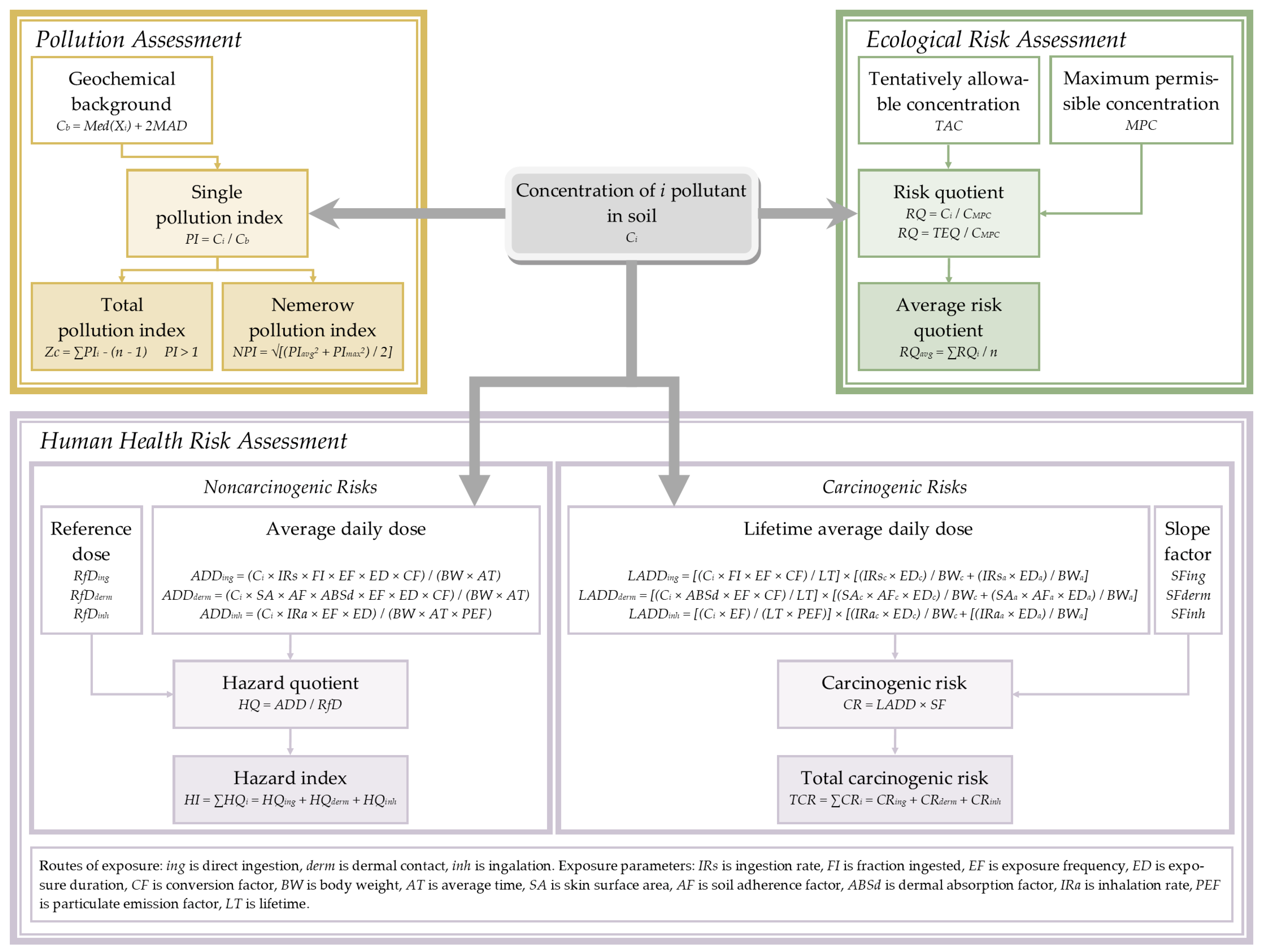
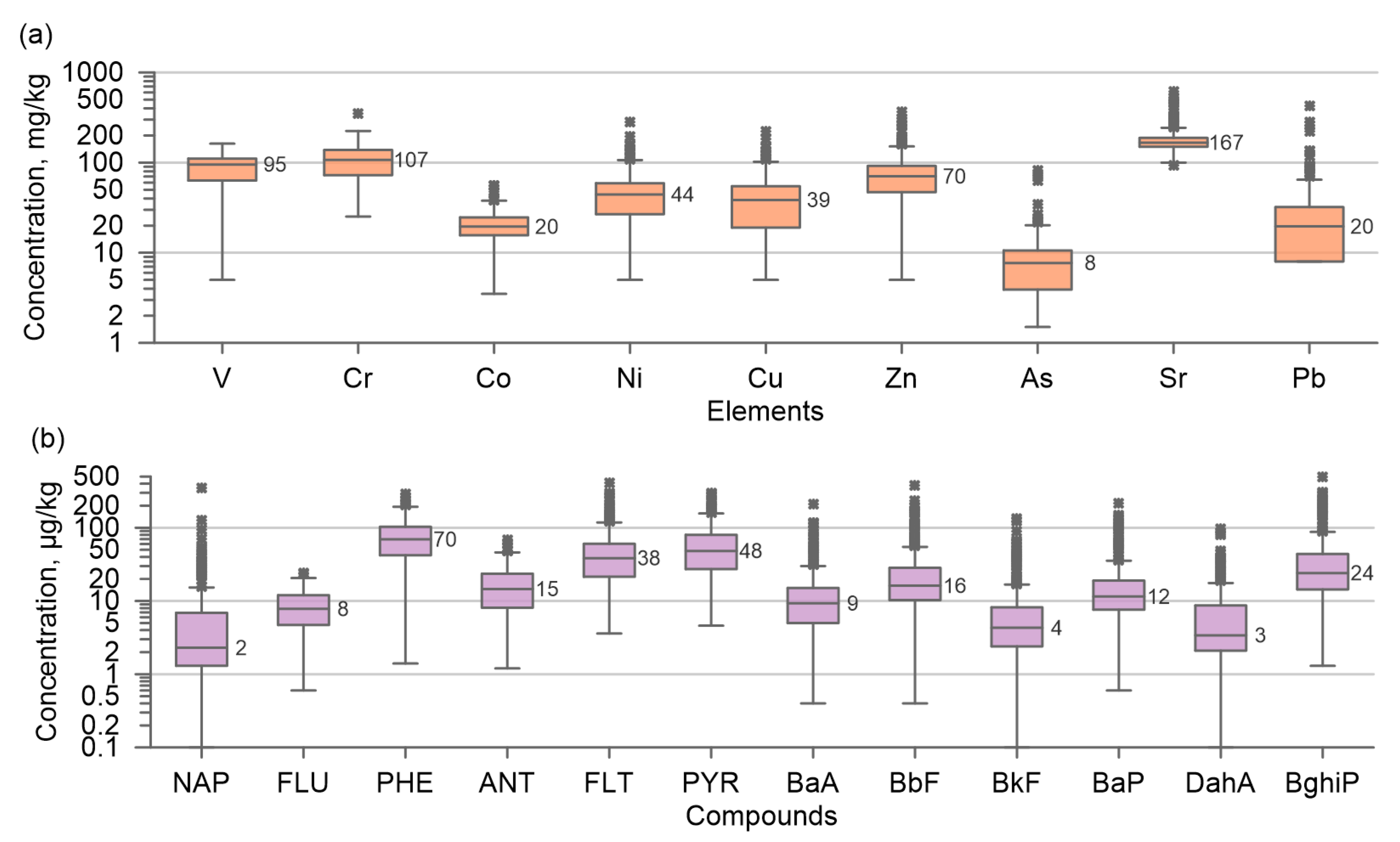
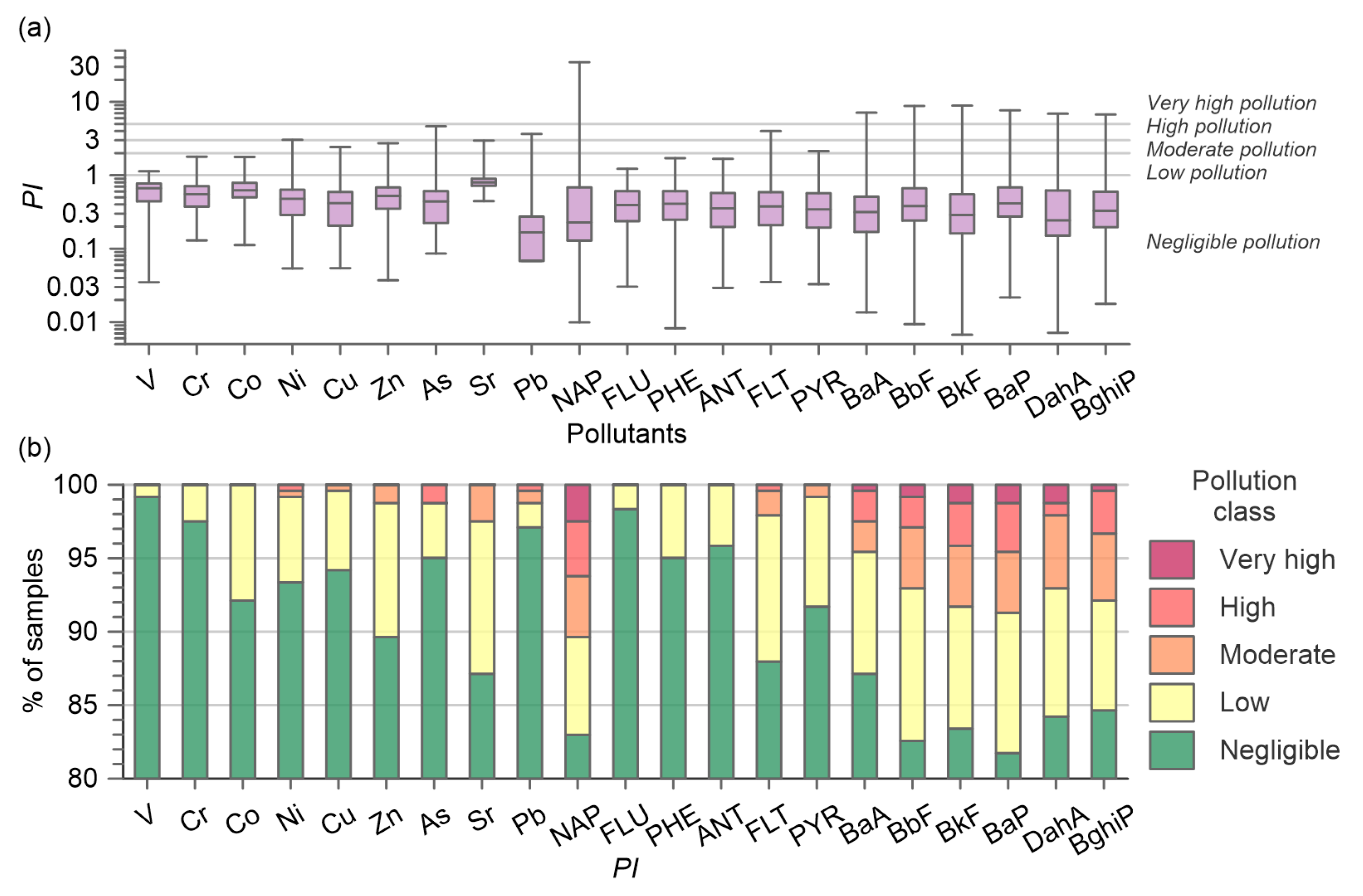

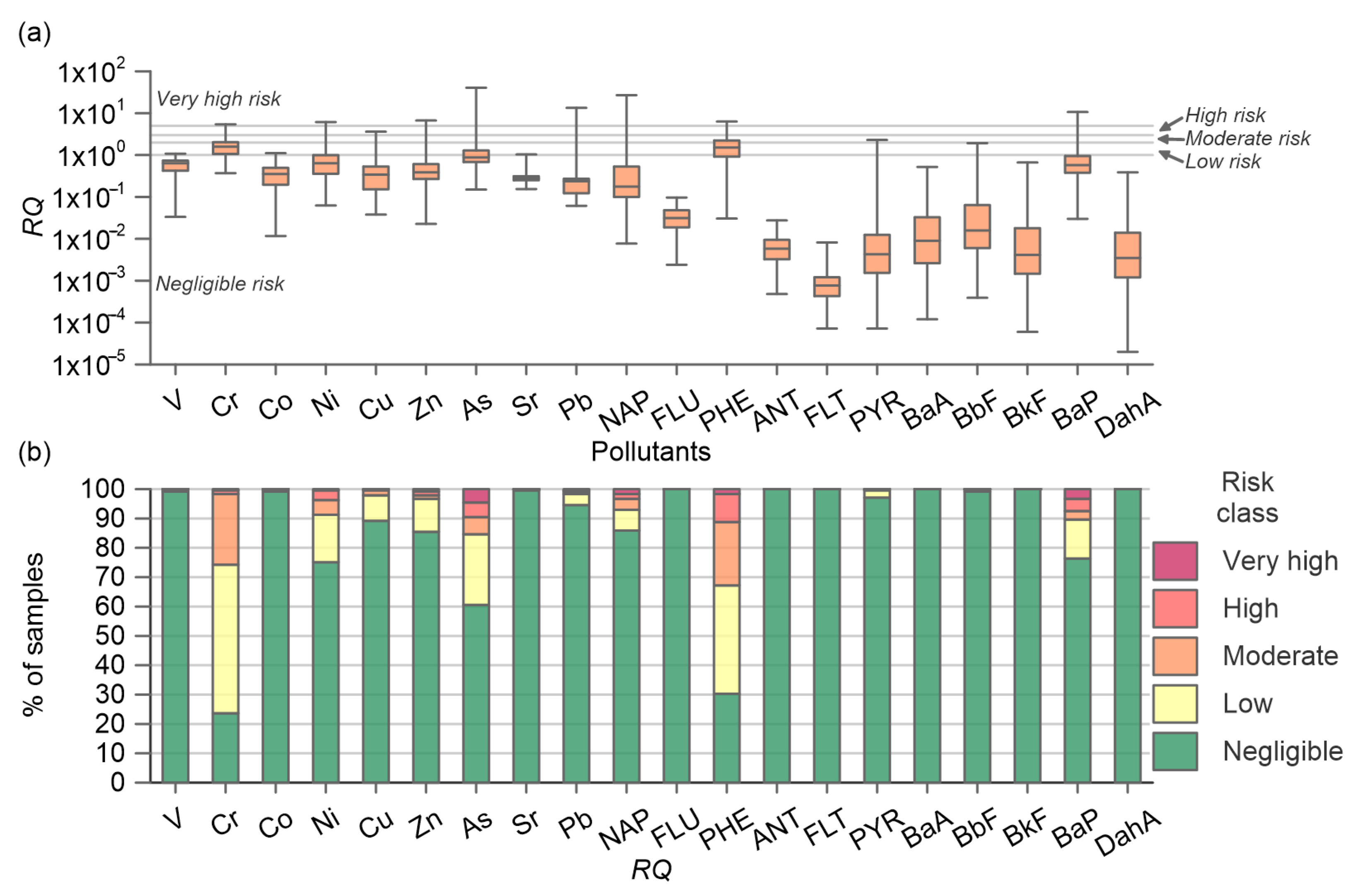
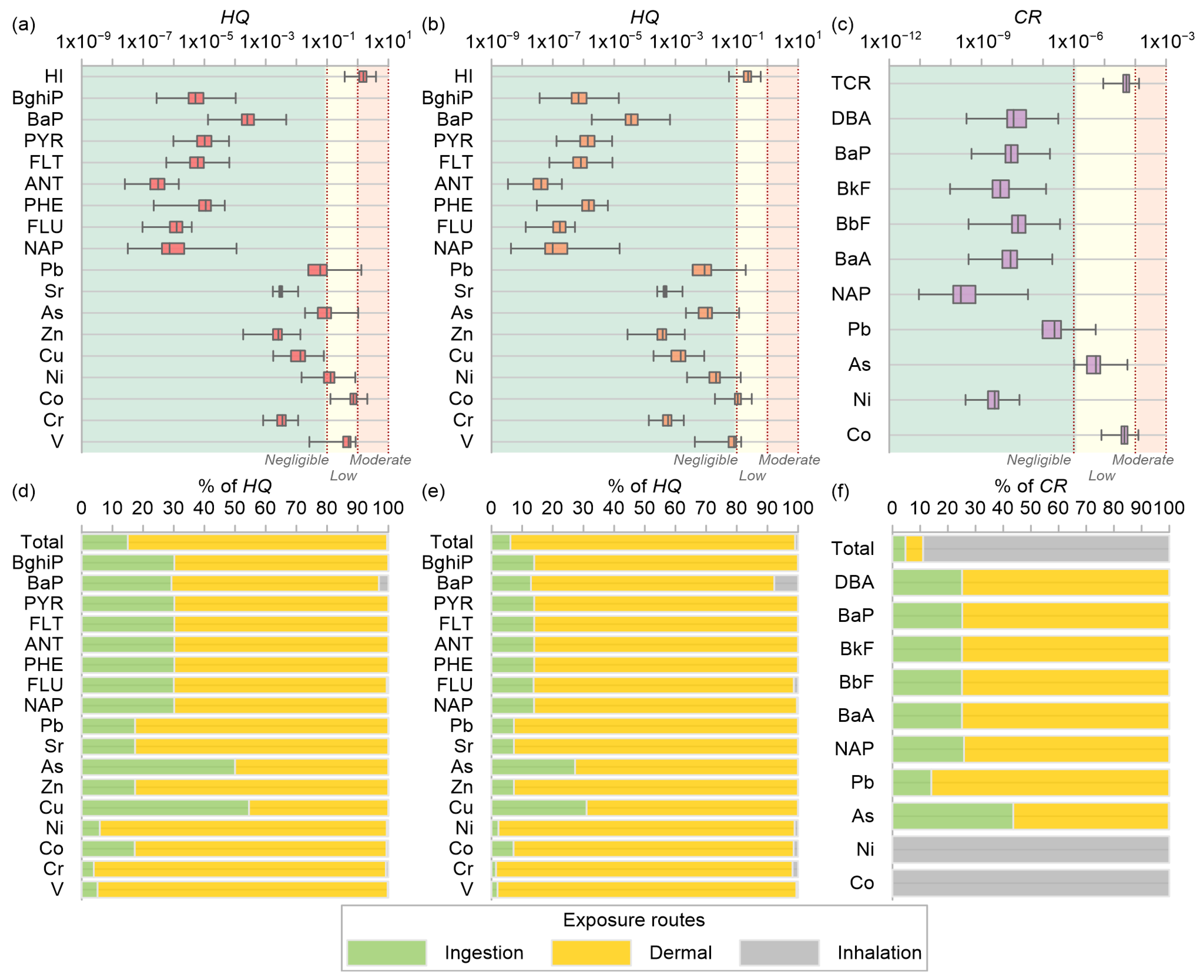
| Class | Pollution Assessment | Ecological Risk Assessment | Human Health Risk Assessment | ||||||
|---|---|---|---|---|---|---|---|---|---|
| PI [67] | Zc [50,70] | NPI [67] | RQ [50,68] | RQavg [71] | HQ [72] | HI [72] | CR [73,74,75] | TCR [73,74,75] | |
| Negligible | ≤1 | ≤4 | ≤0.7 | ≤1 | ≤0.75 | ≤0.1 | ≤1 × 10−6 | ||
| Warning limit | – | 4–8 | 0.7–1 | – | 0.75–1 | – | – | ||
| Low | 1–2 | 8–16 | 1–2 | 1–2 | – | 0.1–1 | 1 × 10−6–1 × 10−4 | ||
| Moderate | 2–3 | 16–32 | 2–3 | 2–3 | >1 | 1–10 | 1 × 10−4–1 × 10−3 | ||
| High | 3–5 | 32–64 | >3 | 3–5 | – | >10 | 1 × 10−3–1 × 10−1 | ||
| Very high | >5 | 64–128 | – | >5 | – | – | >0.1 | ||
| Extreme | – | >128 | – | – | – | – | – | ||
Disclaimer/Publisher’s Note: The statements, opinions and data contained in all publications are solely those of the individual author(s) and contributor(s) and not of MDPI and/or the editor(s). MDPI and/or the editor(s) disclaim responsibility for any injury to people or property resulting from any ideas, methods, instructions or products referred to in the content. |
© 2023 by the authors. Licensee MDPI, Basel, Switzerland. This article is an open access article distributed under the terms and conditions of the Creative Commons Attribution (CC BY) license (https://creativecommons.org/licenses/by/4.0/).
Share and Cite
Konstantinova, E.; Minkina, T.; Antonenko, E.; Sherstnev, A.; Mandzhieva, S.; Sushkova, S.; Rajput, V.D.; Konstantinov, A. Assessing the Combined Pollution and Risks of Potentially Toxic Elements and PAHs in the Urban Soils of the Oldest City in Western Siberia: A Case Study of Tyumen, Russia. Water 2023, 15, 1996. https://doi.org/10.3390/w15111996
Konstantinova E, Minkina T, Antonenko E, Sherstnev A, Mandzhieva S, Sushkova S, Rajput VD, Konstantinov A. Assessing the Combined Pollution and Risks of Potentially Toxic Elements and PAHs in the Urban Soils of the Oldest City in Western Siberia: A Case Study of Tyumen, Russia. Water. 2023; 15(11):1996. https://doi.org/10.3390/w15111996
Chicago/Turabian StyleKonstantinova, Elizaveta, Tatiana Minkina, Elena Antonenko, Aleksey Sherstnev, Saglara Mandzhieva, Svetlana Sushkova, Vishnu D. Rajput, and Alexandr Konstantinov. 2023. "Assessing the Combined Pollution and Risks of Potentially Toxic Elements and PAHs in the Urban Soils of the Oldest City in Western Siberia: A Case Study of Tyumen, Russia" Water 15, no. 11: 1996. https://doi.org/10.3390/w15111996







